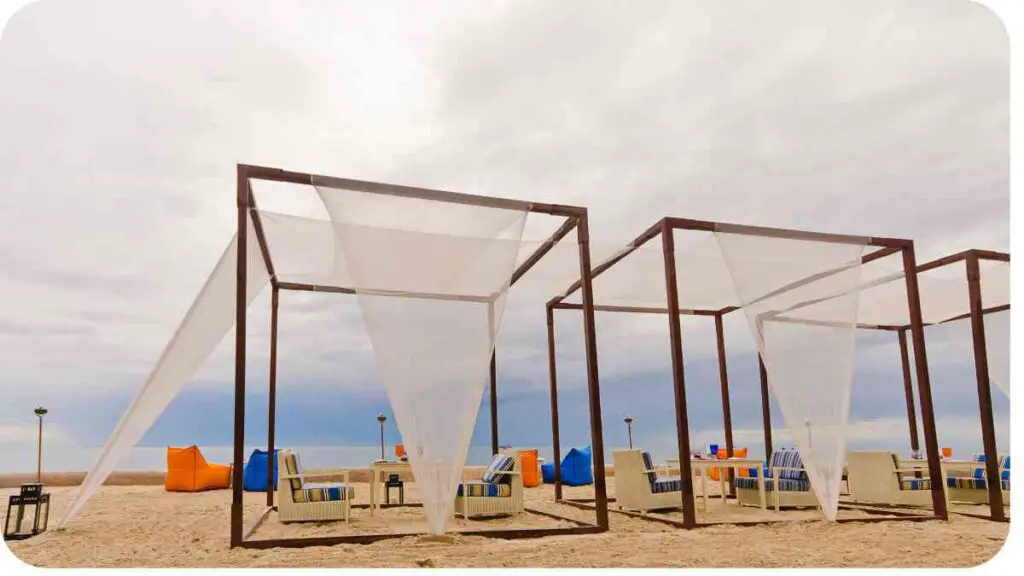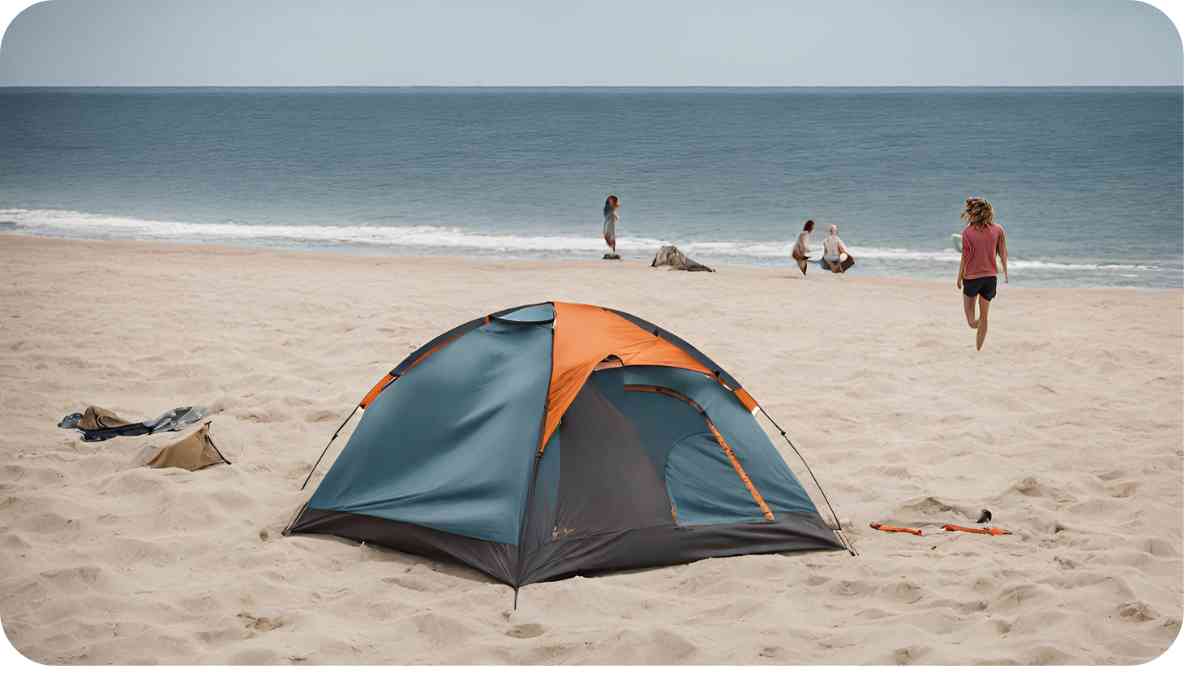Dreaming of a serene day at the beach, sheltered by the shade of your own tent? Many beachgoers wonder whether it’s permissible to set up a tent on the sandy shores. In this comprehensive guide, we’ll explore the ins and outs of beach tent regulations, benefits, considerations, and more.
Whether you’re planning a family outing or a solo retreat, understanding the rules and best practices can make all the difference in your beach experience.
| Takeaways |
|---|
| Check local regulations before pitching a tent on any beach. |
| Choose a beach tent that complies with size restrictions and regulations. |
| Secure your beach tent properly using sandbags, stakes, or sand pockets. |
| Practice Leave No Trace principles and clean up after yourself. |
| Store your beach tent properly to prolong its lifespan and maintain its integrity. |
2. Understanding Beach Tent Regulations

Before you start packing your beach gear, it’s crucial to familiarize yourself with local regulations regarding tent usage. While some beaches welcome tents with open arms, others have strict policies in place to protect the environment and ensure the safety of visitors.
Planning an event? Discover the cost-effective rental rates for a 30×60 tent to accommodate your guests comfortably.
Factors such as beach ownership, conservation efforts, and public safety influence these regulations.
In the United States, for instance, many coastal areas enforce restrictions on tent size, placement, and duration of stay. National parks and wildlife preserves often have specific guidelines to preserve fragile ecosystems and wildlife habitats. Additionally, private beaches may have their own set of rules dictated by the property owner or management.
To avoid any unpleasant surprises, check with local authorities or beach management agencies for up-to-date information on tent regulations before heading out.
Table: Beach Tent Regulations in Different Countries
| Country | Tent Regulations |
|---|---|
| United States | – Size restrictions<br>- Placement guidelines<br>- Duration limits |
| Australia | – Permits may be required<br>- Restrictions on protected areas |
| United Kingdom | – Local council regulations vary<br>- Some beaches have designated tent zones |
| Thailand | – National park restrictions<br>- Conservation efforts may limit tent usage |
| Canada | – Provincial park regulations<br>- Wildlife conservation areas may have strict rules |
3. Benefits of Setting Up a Tent on the Beach

Pitching a tent on the beach offers numerous advantages, making it a popular choice for beachgoers seeking comfort and convenience. Here are some key benefits:
- Shade and Shelter: Beach tents provide a respite from the sun’s harsh rays, allowing you to enjoy the outdoors while staying protected from UV exposure. They also offer shelter from wind and light rain, enhancing your overall beach experience.
- Privacy: With a tent, you can create your own private oasis amidst the bustling beach crowds. Whether you’re changing into swimwear or simply seeking a quiet space to relax, a tent provides a sense of seclusion.
- Storage: Tents offer a designated space to store your belongings, keeping them organized and protected from sand, water, and potential theft. You can safely stow away valuables such as electronics, beach towels, and snacks while you explore or swim.
- Comfort: By setting up a tent, you can enjoy added comfort during your beach outing. Lounge chairs, beach blankets, and inflatable mattresses can be arranged inside the tent, creating a cozy spot to unwind and soak up the seaside ambiance.
- Versatility: Beach tents come in various sizes and designs, catering to different preferences and needs. Whether you’re a solo traveler, a couple, or a family with children, there’s a tent option that suits your group size and desired level of comfort.
Hosting a party? Explore the expenses involved in tenting tables and chairs to create a festive atmosphere for your guests.
4. Factors to Consider Before Pitching a Tent
While beach tents offer numerous benefits, there are several factors to consider before setting one up:
- Regulations: As mentioned earlier, familiarize yourself with local regulations regarding tent usage to ensure compliance and avoid fines or penalties.
- Wind Resistance: Choose a sturdy, wind-resistant tent that can withstand gusty beach conditions. Look for models with sand pockets or stakes for added stability.
- Sun Protection: Opt for a tent with UV-resistant fabric to shield you from harmful sun rays. Consider additional sun protection measures such as applying sunscreen and wearing protective clothing.
- Beach Accessibility: Assess the accessibility of the beach location to determine whether it’s suitable for pitching a tent. Steep slopes, rocky terrain, or crowded areas may pose challenges for setup.
- Environmental Impact: Practice Leave No Trace principles by minimizing your environmental footprint. Avoid disturbing sensitive habitats, wildlife nesting areas, or protected dunes when choosing a tent location.
By carefully considering these factors, you can ensure a safe, enjoyable, and environmentally responsible beach tent experience.
5. Popular Beaches with Tent-Friendly Policies
While beach tent regulations vary from one location to another, there are several renowned beaches around the world known for their tent-friendly policies. These destinations attract visitors seeking a perfect blend of sun, sand, and relaxation. Here are a few notable examples:
- Cannon Beach, Oregon, USA: This picturesque stretch of coastline in Oregon allows visitors to set up tents on the sandy shores, offering stunning views of iconic landmarks such as Haystack Rock.
- Fraser Island, Australia: As the world’s largest sand island, Fraser Island boasts pristine beaches where camping and tent accommodation are permitted in designated camping areas.
- Tofino, British Columbia, Canada: Nestled on the west coast of Vancouver Island, Tofino is renowned for its rugged beauty and surf culture. Many beachfront campsites welcome tents, allowing visitors to immerse themselves in nature.
- Koh Phi Phi, Thailand: The idyllic beaches of Koh Phi Phi offer crystal-clear waters and soft white sands, providing an ideal setting for beach camping. Several resorts and beachfront accommodations offer tent rentals for visitors.
- Porthcurno Beach, Cornwall, United Kingdom: With its turquoise waters and dramatic cliffs, Porthcurno Beach is a popular destination for beachgoers in the UK. Camping is permitted in designated areas, allowing visitors to enjoy the stunning scenery overnight.
These are just a few examples of beaches where setting up a tent is allowed and even encouraged. Before planning your beach getaway, research the specific policies and guidelines for your chosen destination to ensure a seamless experience.
Curious about duration? Learn how long firework tents typically stay open and plan your visit accordingly for the best selection.
6. Tips for Responsible Beach Tent Usage

While setting up a tent on the beach can enhance your experience, it’s essential to practice responsible and considerate behavior to minimize your impact on the environment and fellow beachgoers. Here are some tips for responsible beach tent usage:
- Choose a Suitable Location: Select a spot away from high tide lines, dunes, and sensitive habitats to minimize environmental damage. Look for designated camping areas or areas where other beachgoers have set up tents to avoid overcrowding.
- Secure Your Tent Properly: Ensure your tent is securely anchored to the ground using stakes, sandbags, or sand pockets to prevent it from blowing away in strong winds. Avoid using heavy objects like rocks, as they can cause damage to the beach ecosystem.
- Pack Out What You Pack In: Practice Leave No Trace principles by cleaning up after yourself and disposing of all trash properly. Pack out any waste, including food wrappers, beverage containers, and cigarette butts, to keep the beach clean and pristine for future visitors.
- Respect Wildlife: Be mindful of local wildlife and refrain from disturbing nesting birds, marine mammals, or other animals that call the beach home. Keep a safe distance and avoid feeding or approaching wildlife to prevent stress or harm.
- Minimize Noise and Disturbance: Respect the peace and tranquility of the beach environment by keeping noise levels to a minimum. Avoid playing loud music, shouting, or engaging in disruptive behavior that may disturb other beachgoers or wildlife.
- Be Fire Safe: If permitted, use portable stoves or designated fire pits for cooking and campfires. Follow all fire regulations and guidelines to prevent accidental fires and protect the beach ecosystem.
By following these tips, you can enjoy the benefits of beach tent usage while minimizing your impact on the environment and respecting the rights of others to enjoy the beach.
7. Types of Beach Tents
Beach tents come in various shapes, sizes, and designs, each tailored to specific preferences and needs. Whether you’re looking for compact portability or spacious comfort, there’s a beach tent option to suit your requirements. Here are some common types of beach tents:
Pop-Up Beach Tents
Pop-up beach tents are known for their ease of setup and portability. These tents typically feature a collapsible frame that automatically pops open when removed from its carrying case. With no assembly required, pop-up tents are perfect for beachgoers who value convenience and efficiency. They come in a variety of sizes and designs, from compact two-person shelters to larger family-sized tents.
Enhancing your event ambiance? Discover tips for hanging curtains in a party tent to create an elegant and inviting space for your guests.
Canopy Tents
Canopy tents, also known as sun shelters or beach umbrellas, offer ample shade and protection from the sun’s rays. These freestanding structures feature a durable canopy supported by a sturdy frame, providing a spacious sheltered area for relaxation and socializing. Canopy tents come in a range of sizes, from small beach umbrellas to large gazebos capable of accommodating multiple people.
Dome Tents
Dome tents are characterized by their dome-shaped design, which offers excellent stability and wind resistance. These tents typically feature a lightweight yet durable frame made of fiberglass or aluminum poles, with a waterproof rainfly to provide protection from the elements. Dome tents come in various sizes, with some models offering additional features such as windows, ventilation panels, and storage pockets.
Cabana Tents
Cabana tents are designed for ultimate comfort and privacy on the beach. These enclosed shelters feature walls on all sides, providing a secluded space for changing clothes, taking naps, or seeking refuge from the sun and wind. Cabana tents often have zippered doors and windows for ventilation and privacy, as well as interior pockets for storing belongings. They come in a range of sizes and styles, with some models featuring built-in flooring for added comfort.
Beach Tent Comparison Table
To help you choose the right beach tent for your needs, here’s a comparison table highlighting the key features of each type:
| Type | Features | Pros | Cons |
|---|---|---|---|
| Pop-Up Beach Tents | Easy setup, portability | Quick assembly, compact size | Limited space, may lack durability |
| Canopy Tents | Ample shade, spacious | Provides shade for larger groups | Less wind-resistant, bulky to transport |
| Dome Tents | Stability, weather resistance | Wind-resistant design, durable materials | Longer setup time, less ventilation |
| Cabana Tents | Privacy, comfort | Enclosed space for changing or napping | Bulkier and heavier, may be challenging to set up |
Consider your specific needs and preferences when choosing a beach tent, and opt for a model that offers the features and functionality that best suit your beach-going lifestyle.
8. Beach Tent Setup Guide
Setting up a beach tent may seem daunting at first, but with the right approach, it can be a breeze. Follow these step-by-step instructions to ensure a smooth and hassle-free setup:
Step 1: Choose a Suitable Location
Select a flat, open area away from high tide lines, dunes, and sensitive habitats. Look for a spot with firm sand that will provide stability for your tent. Avoid areas with sharp rocks, debris, or potential hazards.
Step 2: Unpack the Tent
Remove the tent from its carrying case and lay it flat on the ground with the bottom facing down. Spread out the fabric and make sure all parts of the tent are easily accessible.
Step 3: Assemble the Frame
If you’re using a pop-up tent, simply grasp the center of the frame and gently toss it upward. The tent should automatically pop open and take shape. For other types of tents, assemble the frame according to the manufacturer’s instructions, inserting poles into designated sleeves or connectors.
Step 4: Secure the Tent
Once the tent is fully assembled, use stakes, sandbags, or sand pockets to secure it to the ground. Insert stakes through the loops or grommets located at the base of the tent, ensuring they are driven deep into the sand for maximum stability. If your tent has sand pockets, fill them with sand to anchor the tent securely in place.
Step 5: Adjust and Secure Guy Lines (if applicable)
If your tent comes with guy lines or tie-downs, attach them to the tent’s corners or frame and secure them to nearby stakes or anchors. Adjust the tension of the guy lines to ensure the tent remains stable in windy conditions.
Step 6: Final Adjustments
Once the tent is secured, make any necessary adjustments to ensure it is properly aligned and taut. Check for any wrinkles or sagging areas and adjust the stakes, guy lines, or frame as needed to achieve optimal tension.
Step 7: Enjoy Your Sheltered Oasis
With your beach tent set up and secure, it’s time to relax and enjoy your sheltered oasis. Arrange your beach chairs, towels, and other belongings inside the tent, and kick back while soaking up the sun and sea breeze.
By following these simple steps, you can easily set up a beach tent and create your own cozy retreat on the sandy shores.
9. Beach Tent Maintenance Tips
To ensure your beach tent remains in optimal condition and continues to provide reliable shelter for your beach outings, regular maintenance is essential. Here are some maintenance tips to help prolong the life of your beach tent:
Concerned about tent fumigation? Understand how long a tent typically stays on during fumigation to ensure a safe and effective process.
1. Clean After Each Use
After your beach excursion, thoroughly clean your tent to remove sand, salt, sunscreen, and other debris that may accumulate during use. Shake out sand and debris from the fabric, and rinse the tent with fresh water to remove salt and grime. Allow the tent to air dry completely before packing it away to prevent mold and mildew growth.
2. Check for Damage
Inspect your tent for any signs of wear and tear, such as tears, holes, or damaged seams. Repair any damage promptly using a patch kit or seam sealer to prevent further deterioration. Pay close attention to areas prone to stress, such as seams, corners, and attachment points.
3. Store Properly
Store your beach tent in a cool, dry place away from direct sunlight when not in use. Avoid folding or compressing the tent when storing it to prevent creases and damage to the fabric. Use the carrying case or storage bag provided by the manufacturer to protect the tent from dust, moisture, and pests.
4. Treat Mold and Mildew
If mold or mildew develops on your tent, clean it promptly to prevent further growth and damage. Mix a solution of mild detergent and water, and gently scrub the affected areas with a soft brush or sponge. Rinse thoroughly with fresh water and allow the tent to air dry completely before storing it.
5. Maintain Zippers and Fasteners
Periodically lubricate zippers and fasteners with silicone spray or lubricant to keep them functioning smoothly. Check for any signs of corrosion, rust, or damage, and replace damaged components as needed to ensure proper operation.
6. Avoid Overexposure to Sunlight
Extended exposure to direct sunlight can cause UV damage to tent fabrics and materials, leading to fading, weakening, and deterioration over time. Whenever possible, set up your beach tent in shaded areas or use additional sun protection measures such as umbrellas or canopies to minimize sun exposure.
7. Follow Manufacturer’s Instructions
Refer to the manufacturer’s instructions and guidelines for specific care and maintenance recommendations tailored to your beach tent model. Following these instructions will help you preserve the integrity and performance of your tent for years to come.
By following these maintenance tips, you can prolong the lifespan of your beach tent and ensure it remains a reliable and enjoyable shelter for your beach adventures.
10. Environmental Impact of Beach Tents
While beach tents offer comfort and convenience for beachgoers, their presence can have environmental implications if not used responsibly. Understanding the potential environmental impact of beach tents is essential for promoting sustainable beach practices and preserving fragile coastal ecosystems. Here are some key considerations:
1. Habitat Disturbance
Setting up tents on the beach can disrupt natural habitats and wildlife nesting areas, particularly in sensitive coastal ecosystems. Tents may inadvertently trample vegetation, disturb sand dunes, and disturb nesting birds or marine animals, leading to habitat degradation and loss.
2. Beach Erosion
Improperly anchored or abandoned tents can contribute to beach erosion by trapping sand and altering natural sediment movement patterns. This can result in the loss of beachfront and exacerbate erosion issues, particularly in areas already susceptible to coastal erosion and sea level rise.
3. Plastic Pollution
Many beach tents are made from synthetic materials such as polyester or nylon, which can shed microplastics when exposed to UV radiation and saltwater. Over time, these microplastics can accumulate in the marine environment, posing a threat to marine life and ecosystem health.
4. Waste Generation
Beach tents often come packaged with stakes, poles, and other accessories, which can contribute to waste generation if not disposed of properly. Abandoned or discarded tents left on the beach can become marine debris, posing entanglement and ingestion hazards to marine animals.
5. Visual Pollution
The proliferation of beach tents can detract from the natural beauty of the coastal landscape, altering the aesthetic appeal of the beach environment. Rows of tents can obstruct views, diminish scenic vistas, and detract from the overall visitor experience.
Promoting Responsible Beach Tent Usage
To mitigate the environmental impact of beach tents, it’s essential to promote responsible usage practices among beachgoers. Here are some strategies to consider:
- Educational Outreach: Raise awareness about the environmental consequences of beach tents through educational campaigns, signage, and outreach efforts. Encourage beachgoers to minimize their footprint and respect natural habitats.
- Regulatory Measures: Implement and enforce regulations governing beach tent usage, including restrictions on tent size, placement, and duration of stay. Work with local authorities and beach management agencies to develop and enforce responsible beach policies.
- Alternative Solutions: Explore alternative shelter options that minimize environmental impact, such as lightweight sun umbrellas, portable shade structures, or designated tent zones with minimal habitat disturbance.
- Pack-in, Pack-out: Encourage a “pack-in, pack-out” mentality among beachgoers, emphasizing the importance of cleaning up after themselves and properly disposing of all waste, including tents and accessories.
- Community Engagement: Foster a sense of stewardship and community responsibility among beachgoers by organizing beach cleanups, restoration projects, and volunteer efforts to preserve and protect coastal environments.
By promoting responsible beach tent usage and fostering a culture of environmental stewardship, we can ensure that future generations can continue to enjoy the beauty and biodiversity of our coastal treasures.
11. Conclusion
Beach tents offer a convenient and comfortable way to enjoy the sun, sand, and surf while providing shelter from the elements. However, it’s essential to use them responsibly to minimize their environmental impact and preserve the beauty of our coastal environments. By following regulations, practicing Leave No Trace principles, and promoting sustainable beach practices, we can ensure that beach tents remain a source of enjoyment for generations to come.
Whether you’re lounging with family and friends, seeking solitude by the sea, or simply enjoying the beach lifestyle, a well-placed and properly maintained beach tent can enhance your experience and provide a cozy retreat amidst the beauty of nature.
Remember to choose a suitable location, secure your tent properly, and clean up after yourself to minimize your footprint and protect fragile coastal ecosystems. By working together to promote responsible beach tent usage, we can all do our part to preserve our beaches for future generations to enjoy.
So next time you head to the beach, don’t forget your sunscreen, beach towel, and of course, your trusty beach tent. With a little care and consideration, you can enjoy all the benefits of beach tent living while treading lightly on the sand.
Happy beaching!
Further Reading
- Ozbargain: This article provides insights into beach tent regulations and tips for setting up a tent on the beach.
- Outdoors.com: Explore the pros and cons of bringing a tent to the beach and learn about responsible beach tent usage.
- Campshores.com: Discover the benefits of beach tent camping and get practical advice on choosing the right tent for your beach adventure.
FAQs
Can I pitch a tent on any beach?
Yes, but it’s important to check local regulations as some beaches may have restrictions on tent usage.
Are there any size limitations for beach tents?
Many beaches have size restrictions for tents, so be sure to choose a tent that complies with local regulations.
How do I secure my beach tent in windy conditions?
Use sandbags, stakes, or sand pockets to anchor your tent securely to the ground and consider using guy lines for added stability.
Can I leave my beach tent unattended?
It’s generally not recommended to leave your beach tent unattended, as it may pose a safety hazard and could be subject to removal by beach authorities.
What should I do with my beach tent after use?
Clean your beach tent thoroughly, pack it away neatly, and store it in a cool, dry place to prolong its lifespan and maintain its integrity.

I am Hellen James, a professional handywoman with expertise in improving home and garden spaces by using pergolas, gazebos, and tents.


